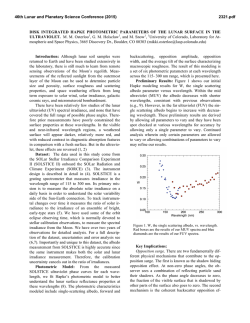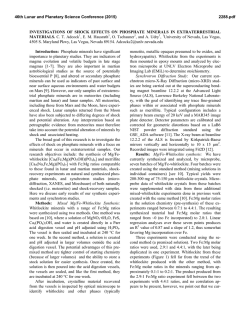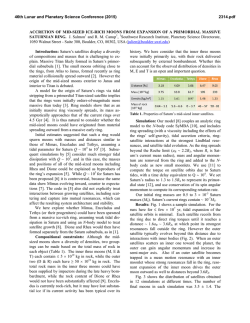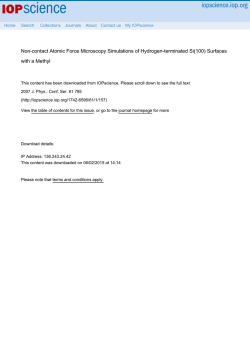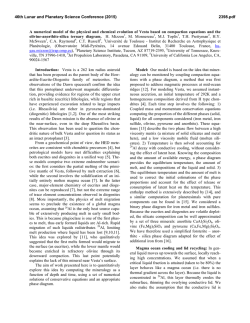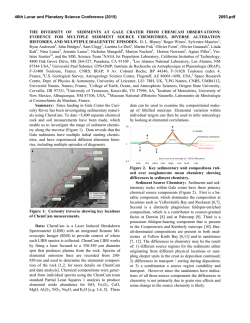
LUNAR TIDAL DISSIPATION. James G. Williams, Dale H. Boggs
46th Lunar and Planetary Science Conference (2015) 1877.pdf LUNAR TIDAL DISSIPATION. James G. Williams, Dale H. Boggs, and J. Todd Ratcliff, Jet Propulsion Laboratory, California Institute of Technology, Pasadena, CA, 91109, USA (e-mail [email protected]). Introduction: The tidal distortion of a gravity field is proportional to Love number k2. Vertical and horizontal distortions are proportional to two other Love numbers h2 and l2. The analysis of lunar laser ranging (LLR) data is sensitive to tides on the Moon. LLR analysis found a strong value (a low Q) for lunar tidal dissipation a decade ago [1]. Analysis of subsequent data have confirmed the low quality factor, Q, and refined the value for dissipation. Recent analyses of GRAIL data have provided an excellent value for the Love number k2 [2-5] and have also detected the strong dissipation [5]. The shape of the curve for dissipation k2/Q vs. tidal period depends on the rheology of the deep mantle. This abstract updates the lunar laser dissipation results at 4 tidal periods from a recent analysis [6]. Theoretical Background: The theory for the effect of tidal dissipation on the tidal distortion and resulting potential is given in [6]. It is suitable for accurate GRAIL analysis. For each periodic tidal term, the amplitude is larger than the elastic response and there is a phase shift. The theory for the effect of tidal dissipation on orientation is presented in [1,6]. Each coefficient for a periodic term is a linear function of k2/Q dissipation values at different tidal periods. LLR Solutions: Lunar laser ranging (LLR) data consisting of 19,361 ranges extending from March 1970 to April 2014 were analyzed. The accuracy has improved with time. On the Earth, McDonald Observatory, Texas, Observatoire de la Côte d’Azur, France, Haleakala Observatory, Hawaii, and Apache Point Observatory in New Mexico have provided extended data sets. Ranges to 5 retroreflectors at different sites provide information on the lunar orientation vs. time, the physical librations. The orientation is specified by the direction of the axis of rotation and rotation about that axis. In addition to standard parameters for retroreflector positions, orbit, station positions, and Earth orientation, the solution includes parameters for dissipation related libration terms at 1 month, 1 yr, 3 yr, and 6 yr. These libration terms depend on tidal dissipation at a variety of tidal periods including the foregoing. We derive Q = 38±4 at 1 month and Q = 41±9 at 1 yr. Two longer periods provide approximate limits of Q≥74 at 3 years, and Q≥58 at 6 years. These values correspond to k2/Q=(6.4±0.6)x10–4 at 1 month, k2/Q=(6.2±1.4)x10–4 at 1 year, k2/Q≤3.5×10–4 at 3 years, and k2/Q≤4.5×10–4 at 6 years. See [6] for details. Dissipation vs. Period and Rheology: The strongest dissipation is expected for the deep mantle. A prime suspect is the attenuating layer that lies above the liquid core. Strong seismic dissipation was discovered by Apollo seismology and is suspected to be a partial melt [7,8]. Weber et al. [9] derive a 150 km thick attenuating layer from radii of 330 to 480 km. We are concerned with dissipation that is associated with rigidity µ rather than bulk modulus κ. It is convenient to represent µ with a complex variable. The imaginary part is from dissipation associated with shear. For elastic distortions, the Love number k2 is computed from µ and κ. With dissipation, both µ and k2 are complex. The (negative) imaginary part of k2 gives k2/Q. The ratio of imaginary to real parts gives the tangent of the negative phase shift. A fundamental computation of complex Love numbers evaluates the elastic equations with complex variables. An alternative approach uses a Taylor expansion of elastic k2 with respect to µ in each layer and then multiplies by complex µ. The former procedure was used by Harada et al. [10]. The latter approach is used in this study. The rheology of the dissipating regions determines how the dissipation k2/Q depends on tidal period P. Important factors include temperature, stress, grain size, water content, and presence of melt [11,12]. Various models have been used for dissipation vs. tidal period P: a) The time delay model has k2/Q is proportional to 1/P. b) A constant phase shift and k2/Q is a simple model. c) Maxwell dissipation results when viscosity can cause unlimited distortion. Then k2/Q ∝ P. d) The Andrade model has k2/Q ∝ Pw. This model, with a positive w, is frequently used to fit laboratory data. e) A single relaxation time model produces a peaked function of k2/Q vs. period. This is an example of dissipation with limited distortion. It may be an appropriate model for a partial melt. f) An absorption band model results from the superposition of many relaxation times with minimum and maximum limits. With an exponential distribution of relaxation times between the limits, the dissipation resembles an Andrade model between the limits and decreases outside the limits. Comparisons: We compare the foregoing 6 models to the LLR results. Figure 1 shows 6 curves of k2/Q vs. tidal period. All curves pass through the monthly (27.2 day) value of k2/Q. Only 3 curves also pass through the annual value; they are the constant k2/Q, the single relaxation time, and the absorption band models. The latter two curves also satisfy the two LLR upper limits. Only the single relaxation time and the absorption band models satisfy the 4 LLR results. Note that an attempt to fit all 4 of the LLR results with an Andrade curve would lead to a negative slope. This explains the negative exponent w found in [1,4]. 46th Lunar and Planetary Science Conference (2015) Interpretation: Several papers have attempted to explain the low tidal Q. Harada et al. [10] proposed that low viscosity was the cause, possibly from a partial melt in the attenuating layer. The single relaxation time curve is the analogue. Applying Love number expressions for a homogeneous body, Efroimsky [13,14] modeled the decrease at long period with a low global viscosity. He obtained a peaked curve for k2/Q vs. tidal period that resembled a single relaxation time curve. Although a low global viscosity Moon is not realistic, the peaked k2/Q curve explained the negative exponent w found in [1,4]. Nimmo et al. [15] applied an absorption band model and concluded that deep hot mantle material was sufficient for low Q and a partial melt was not needed. Karato [16] proposed that the low lunar Q came from water content in the mantle. A partial melt was not required. Combining a variety of evidence, Khan et al. [17] favored a partial melt in the attenuating zone. There is a diversity of opinion. Two models give satisfactory fits to the LLR dissipation results (Figure 1): 1) a partial melt causing a single relaxation time curve and 2) an absorption band model appropriate for solid material. We are not able to explain the observed strength of dissipation with the 150 km thick attenuating zone of [9]. At the zero shear strength limit, a ~200 km thick layer is needed. This thickness would place the top of the attenuating layer adjacent to the bottom of the deep moonquake zone [18]. The lunar mantle has several layers and strong dissipation could extend over multiple layers. For example, a partial melt in a deep attenuating layer could cause a single relaxation time component while higher layers could add an absorption band component. Summary: LLR analysis provides dissipation information at 4 tidal periods. Two k2/Q values and two upper limits are shown in Figure 1. Also shown are examples of 6 models for k2/Q vs. tidal period. Of the 6, only the single relaxation time and absorption band models are good fits to the LLR results. The former could indicate a deep partial melt whereas the latter does not. Future tidal measurements at additional periods would help reveal the source of lunar tidal dissipation. Acknowledgements: We thank the lunar laser ranging stations at McDonald Observatory, Texas, Observatoire de la Côte d’Azur, France, Haleakala Observatory, Hawaii, and Apache Point Observatory in New Mexico for providing the ranges that made this study possible. The research described in this abstract was carried out at the Jet Propulsion Laboratory of the California Institute of Technology, under a contract with the National Aeronautics and Space Administration. Government sponsorship acknowledged. References: [1] Williams J. G. et al. (2001) J. Geophys. Res., 106, 27,933-27,968. [2] Konopliv A. S. et al (2013) J. Geophys. Res. Planets 118, 1415–1434, 1877.pdf doi:10.1002/jgre.20097. [3] Lemoine F. G. et al. (2013) J. Geophys. Res. Planets 118, 1676–1698, doi:10.1002/jgre.20118. [4] [Williams J. G. et al. (2014) J. Geophys. Res. Planets, 119, 1546–1578, doi:10.1002/2013JE004559. [5] Williams J. G. et al. (2015) The deep lunar interior from GRAIL, LPSC 46, abstract 1380. [6] Williams J. G. and Boggs D. H. (2014) J. Geophys. Res., submitted. [7] Nakamura Y. et al. (1973) Science 181, 49–51, doi:10.1126/science.181.4094.49. [8] Nakamura Y. et al. (1974) Geophys. Res. Lett. 1, 137–140, doi:10.1029/GL001I003p00137. [9] Weber R. C. et al. (2011) Science 331, 309–312, doi:10.1126/science.1199375. [10] Harada Y. et al. (2014) Nature Geoscience 7, 569–572, doi:10.1038/ngeo2211. [11] Karato S. and Spetzler H. A. (1990) Rev. Geophys. 28, 399–421, doi:10.1029/RG028I004p00399. [12] Karato S. (2010) Gondwana Research 18, 17–45, doi:10.1016/j.gr.2010.03.004. [13] Efroimsky, M. (2012) Celest. Mech. Dyn. Astron. 112, 283–330, doi:10.1007/s10569-011-9397-4. [14] Efroimsky, M. (2012) Astrophys. J. 746, 150, doi:10.1088/0004637X/746/2/150. Erratum (2013) Astrophys. J. 763, 150, doi:10.1088/0004-637X/763/2/150. [15] Nimmo F., Faul U. H., and Garnero E. J. (2012) Dissipation at tidal and seismic frequencies in a melt-free Moon, J. Geophys. Research 117, E09005, doi:10.1029/2012JE004160. [16] Karato S. (2013) Earth Pl. Sci. Lett. 384, 144–153, doi:10.1016/j.epsl.2013.10.001. [17] Khan A., Connolly J. A. D., Pommier A., and Noir J. (2014) Geophysical evidence for melt in the deep lunar interior and implications for lunar evolution, J. Geophys. Res. Planets 119, 2197–2221, doi:10.1002/2014JE004661. [18] Nakamura Y. (2005) Far deep moonquakes and deep interior of the Moon, J. Geophys. Res. 110, E01001, doi:10.1029/2004JE002332. Figure 1. Six model curves show the dependence of k2/Q on tidal period. The two circles indicate monthly and annual determinations from LLR data analysis. Upper limits are shown at 3 and 6 years.
© Copyright 2025


